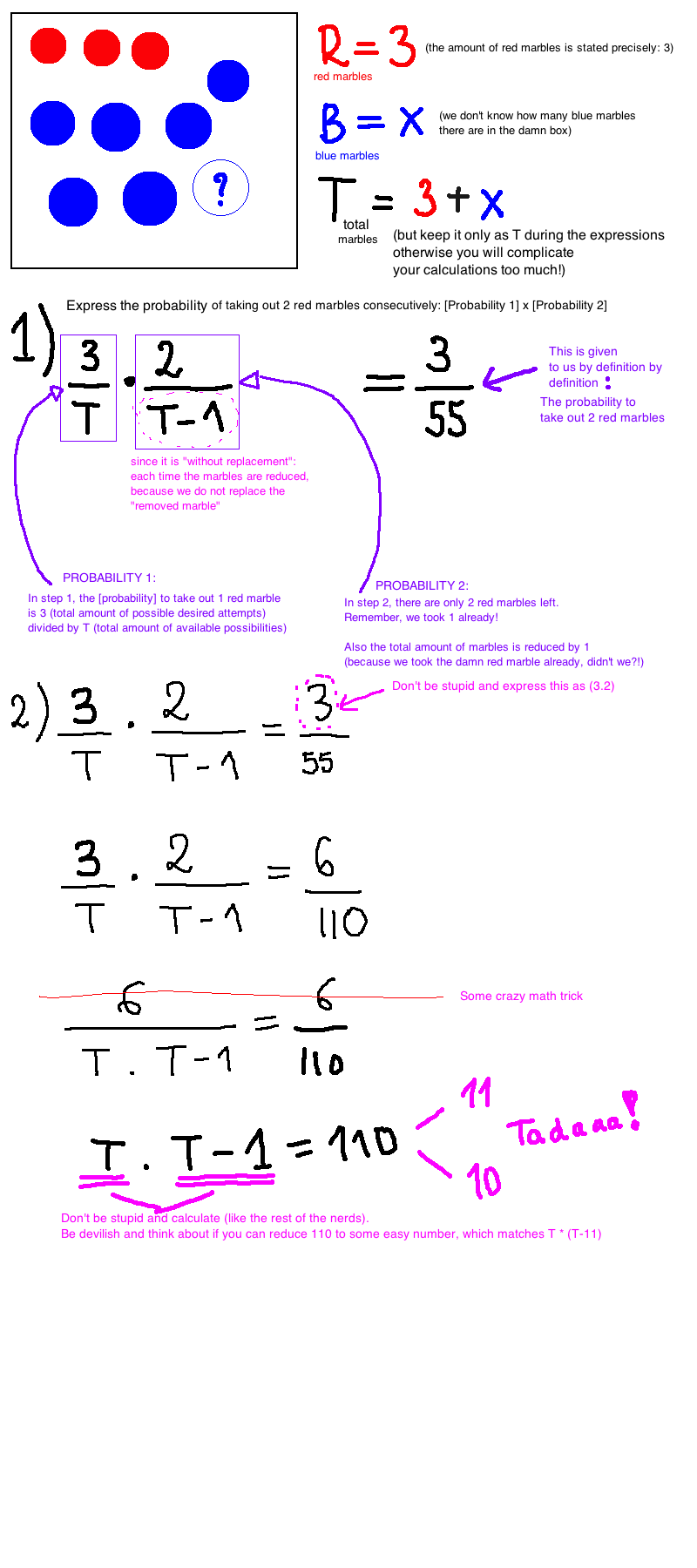
GRE Prep Club Daily Prep
Thank you for using the timer - this advanced tool can estimate your performance and suggest more practice questions. We have subscribed you to Daily Prep Questions via email.
Customized
for You
Track
Your Progress
Practice
Pays
Not interested in getting valuable practice questions and articles delivered to your email? No problem, unsubscribe here.
If the probability of choosing 2 red marbles without replac
[#permalink]
 23 May 2017, 08:49
23 May 2017, 08:49
1
Expert Reply
5
Bookmarks
Question Stats:
 65% (01:52) correct
65% (01:52) correct
 34% (02:06) wrong
34% (02:06) wrong  based on 286 sessions
based on 286 sessions
Hide Show timer Statistics
If the probability of choosing 2 red marbles without replacement from a bag of only red and blue marbles is \(\frac{3}{55}\) and there are 3 red marbles in the bag, what is the total number of marbles in the bag?
A) 10
B) 11
C) 55
D) 110
E) 165
Retired Moderator
Joined: 10 Apr 2015
Posts: 6218
Given Kudos: 136
Re: If the probability of choosing 2 red marbles without replac
[#permalink]
 24 May 2017, 12:55
24 May 2017, 12:55
9
Carcass wrote:
If the probability of choosing 2 red marbles without replacement from a bag of only red and blue marbles is \(\frac{3}{55}\) and there are 3 red marbles in the bag, what is the total number of marbles in the bag?
A) 10
B) 11
C) 55
D) 110
E) 165
Let T = the TOTAL number of marbles in the bag.
We are told that 3 of those marbles are red
P(select a red marble first) = 3/T
Once we've removed the first red marble, there are T-1 marbles remaining and 2 of them are red
So, P(select a red marble second) = 2/(T-1)
Okay, now let's use probability rules to answer the question....
P(select 2 red marbles) = P(select a red marble first AND select a red marble second)
= P(select a red marble first) x P(select a red marble second)
= 3/T x 2/(T-1)
= 6/(T² - T)
We're told that P(select 2 red marbles) = 3/55
So, we can write: 6/(T² - T) = 3/55
Cross multiply to get: 3(T² - T) = (6)(55)
Divide both sides by 3 to get: T² - T = (2)(55)
Evaluate: T² - T = 110
Rearrange: T² - T - 110 = 0
Factor: (T - 11)(T + 10) = 0
So, EITHER T = 11 OR T = -10
Since T cannot be negative, it must be the case that T = 11
Answer:
Show: ::
B
Cheers,
Brent
General Discussion
Re: If the probability of choosing 2 red marbles without replac
[#permalink]
 03 Feb 2018, 21:54
03 Feb 2018, 21:54
2
An easy approach :
Let no: of blue bags be B. Given no: of red bags is 3. Thus
3/(3+B) * 2/(3+B-1) = 3/55 (Probablity without replacement formula)
We need to know 3+B
On solving,
(3+B)(3+B-1)=110
Thus 3+B is 11
Let no: of blue bags be B. Given no: of red bags is 3. Thus
3/(3+B) * 2/(3+B-1) = 3/55 (Probablity without replacement formula)
We need to know 3+B
On solving,
(3+B)(3+B-1)=110
Thus 3+B is 11







